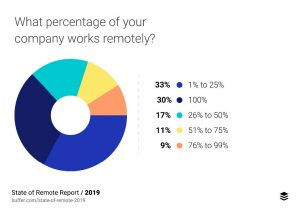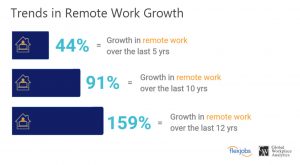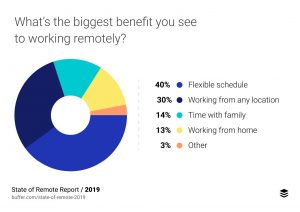Now that you have been forced to expand, secure, and support a remote workforce… what happens next?
By: Peter Jacobson, Director of Business Development, powersolution.com
Although the deployment of remote workforces has been gradually growing over a period of several years, the current pandemic has mandated exponential growth of remote workers in a very short period of time. This creates new challenges from a technical, security, and personnel management perspective.
Anticipate a migration to an increased remote workforce as the new normal
While the opportunity for worker in-office interaction and socializing are significantly reduced or eliminated, there also can be many benefits to a full or partial remote workforce. We believe many of these long-term benefits are currently unknown or underappreciated by managers coping with the current disruption of business operations and rapid transition to increased remote workers.
For companies that balance both remote and in-office workers, there’s a big range when it comes to the percentage of the remote work contingent. Almost the same amount of people reported that all of their teams work remotely and less than 25% of them work remotely. The set up of the teams of companies has a wide range.
In our view, the new normal after the pandemic passes will be a greater appreciation of the benefits associated with a remote workforce. Consequently, we believe companies will increase the percentage of employees that work remotely – resulting in reduced office expenses, increased employee work/life balance advantages, along with certain productivity benefits.
Business continuity is paramount
Maintaining normal or near-normal business operations and minimizing downtime during periods of disruption fall under the umbrella of business continuity. A failure in business continuity and resulting downtime can potentially result in lost revenue and significant reputation damages.
Working remotely, outside of their company’s main location and having a choice of work environment, from home or on the road, is now a key factor for many job seekers when evaluating new career opportunities.
Trends in work growth are showing a major shift upward in the amount of people working remotely in US. Between 2005 to 2017 there was a $159% increase in remote work. Today as many as 4.7 million, or 3.4% of the population, represent a remote workforce in the United States alone.
Although most organizations are currently focused on the current disease outbreak, other common possible business disruptions include cyber-attacks, network issues, power outages, weather conditions, and fires. With respect to cybercrimes, the FBI has reported roughly a quadrupling of online crimes since the breakout of the COVID-19 pandemic.
Communication during and following an emergency presents a variety of challenges. So, crafting an employee safety and communication plan that works is absolutely essential.
Address the methods that will ensure employees are safe during a disaster event
This will depend heavily on the nature and location of your business. Safety planning for a large manufacturing facility will obviously be very different than for a small real estate office, for example. Because of this, it’s very difficult to provide specific best practices for this part of your BC/DR plan. However, the key is to match your safety plan to the specific needs of your organization.
Disasters, natural or man-made, happen all the time. They all have unpredictable consequences for the people and businesses. If you run a company, do you have a business continuity plan for what you and your employees should do in any of these situations? If you have remote employees, what kind of emergency plan do you have involving them?
Provision for communication of essential information to employees following the disaster event
You will need to first gather a variety of information and make sure that it is well documented, easily accessible and stored in a number of secure locations. This should include up-to-date employee contact information (email, mobile and home phone numbers, emergency contact information, etc.). It should also include a methodology for contacting employees.
Technology Considerations
Many home offices do not maintain the same technology standards, including IT security, that are provided at the employee’s office building. The remote equipment and network should be evaluated and documented for functionality and security.
A prevalent technology for securing remote connections is the use of virtual private networks (VPNs). VPNs create an encrypted tunnel between a user’s computer and a remote network. This enables a home PC user to connect to their office computer, as though they were sitting at the desk at the office. VPNs enable secure access an internally hosted line of business applications that haven’t been moved to a software-as-a-service (SaaS)-based solution. VPNs provide a high level of security when properly maintained and secured.
VPNs require proper setup, including addressing capacity and performance issues. Capacity may be restricted by limitations of a firewall. A firewall can be either a hardware device, software, or a combination. The firewall is designed to prevent unauthorized access to or from a private network. This prevents unauthorized Internet users from accessing your private network, which is connected to the Internet.
Some firewalls have capacity limitations on the number of concurrent VPN sessions they can support. Capacity issues need to be monitoring and managed on an ongoing basis.
Additionally, performance issues on the VPN network need to be addressed as they arise. Performance issues can be due to many factors, such as device, network, or application issues. Devices may be outdated or certain users may be consuming a large amount of bandwidth. Separately, the network may have connectivity or other issues and applications may need to be re-configured or modified to eliminate performance issues.
Video communication is another technology that has grown over a period of years, with rapid escalation of growth during the COVID-19 pandemic. Industry data shows video communications traffic and usage growth for certain major video communications providers exceeded 200% in just one month of the pandemic.
In lieu of in-office meetings and hallway impromptu chats, there are many software applications that facilitate online chats, web-based meetings, and real-time messaging. This includes platforms such as Skype, Microsoft Teams, Facetime, GoToMeeting, Google Hangouts, internal blogs, social media, and project management.
There are numerous applications software applications available to provide a wide range of remote workforce functionality.
There are many tasks that can be accomplished by using some of the of the applications available for virtual collaboration and productivity:
- Video Conferencing
- Scheduling
- Projects
- Webinars
- Chatting
- Note Sharing
- Goal Setting
- Reporting
Virtual collaboration tools allow remote employees to engage as if they’re in the same workspace. Employees can use forms of business communication, such as video conferencing, as well as email, instant messages, and the telephone. Business hours could also increase with more flexibility and safety, such as in cases of weather conditions that could limit productivity due to hazardous driving conditions.
Benefits and facilitation of a productive remote workforce
As previously indicated, it is not necessarily intuitive for many organization leaders to appreciate the benefits of a remote workforce. An immediate perceived loss is the lack of ability to see workers at their desks putting in their scheduled hours. Also, not having the opportunity for in-office face-to-face collaboration, creativity, and socializing can be an offset to the benefits.
However, various industry studies and experiences showing that remote workforce advantages often outweigh the perceived disadvantages. In order to garner those advantages, though, management policies and processes need to be established, documented, and maintained to facilitate a healthy and productively environment for both employers and employees.
Forty percent believe that flexible schedule is the biggest benefit of remote work. Working from any location is one of the top priorities, while time with family and working from home are the additional benefits of being part of a remote workforce.
Additionally, a Gallop study showed that employees spending 60% to 80% of their time working remotely had the highest rates of engagement. Other studies show that over 15% of companies worldwide are fully remote, while over 50% of employees work from home at least one day per week.
Overriding major elements of an effective remote workforce are communication and collaboration. Personal connections and relationships are key to employee engagement.
Team collaboration can be facilitated using video and phone calls
Regular checking-in between teams, management, and other departments should be scheduled on an ongoing basis. Also, remote workforce programs should allow for flexibility with customization to accommodate different individual needs of employees. It should be kept in mind that some employees working remotely feel isolated, while other feel liberated and empowered.
A basic premise of a remote workforce is having employees on the payroll that are competent, self-motivated, and won’t abuse the flexibility associated with working at home. Goals should be based on output rather than activities or hours worked.
Contrary to what many may think, remote workers tend to be more productive due to many factors including eliminating commuting and schedule flexibility.
Commuting length, for example, has been attributed to causing higher blood pressure and employee negativity. Also, there is evidence that stress levels are greatly reduced due to eliminating commuting and increasing schedule flexibility. More content, satisfied, and healthier employees can be more productive and contribute more to your business. Rather than spending an average of 50 minutes commuting round-trip each day, this time saved can facilitate a much more favorable work/life balance.
In-office hires are typically restricted to those who can commute locally. In contrast, remote workers can be hired from a much broader geography.
This dramatically increases the talent pool available to facilitate high-quality new hires.
Studies have shown that nearly 70% of millennials would be more inclined to be hired by a company if remote working was offered.
From an employer’s perspective, reducing the percentage of in-office workers can significantly reduce overhead costs, including items such as rent and utilities.
Remote employees tend to be more productive and stay longer at their jobs, reducing the costs of turnover. According to a National Institutes of Health study, remote workers experience higher job satisfaction, reduced stress, lower turnover, and higher performance evaluations.
How COVID-19 pandemic will affect remote workforce after it passes
A consequence of the COVID-19 pandemic will be an accelerated ramp-up of partial and/or full remote workforces after the pandemic has passed.
There are advantages and disadvantages to utilizing a remote workforce in lieu of the in-office work experience. Much of traditional management thinking has been that having employees in the office on a daily basis provides significant benefits. A countervailing view is that much of those in-house activities can be facilitated utilizing software designed to emulate many of the activities that normally would be performed face-to-face in the office. Additionally, there are further offsetting benefits to a remote workforce such as elimination of commuting, reduced employee stress, greater work/life balance, reduced turnover, and improved productivity. It is also important to understand that moving to a remote workforce is not an all- or nothing option. Hybrid business models can be implemented to combine various forms of both in-office and remote work options for employees.
In the end, though, we believe an outcome of the COVID-19 pandemic will be increased appreciation by both employers and employees of the many benefits of remote working.
After gaining experience in expanding, securing, and supporting a remote workforce during the pandemic, we believe organizations will permanently expand their remote workforce programs and options for employees.
If a company is fundamentally flawed and suffering from things such as bad management, weak company culture, low morale, or other dysfunctional factors – it is likely that moving to a remote workforce will not help to ameliorate those issues. However, well managed companies that focus on the employee first to ultimately maximize productivity and company performance are in a great position to leverage the benefits of a full or partial remote workforce.
Contact me for details on remote workforce for your organization:
Peter Jacobson
Director of Business Development
powersolution.com
445 Godwin Avenue
Midland Park, NJ 07432
P: 201-493-1414 x321
C: 917-531-3740
peterj@powersolution.com



